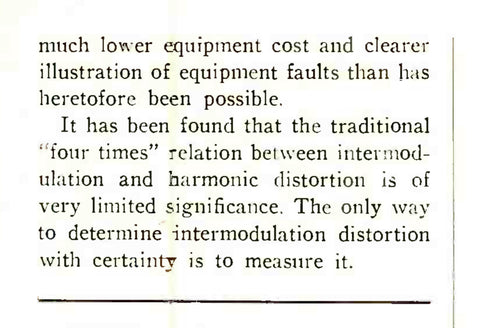
Often referred to the golden era of hifi, there is plenty of mystique and nostalgia associated with equipment from this era. But what drove the engineer’s mind in that day to produce such wonderful equipment? Did they just luck out and land on materials and technologies that resulted in beautiful sound? Or was there more method involved? Was the approach different than it is today?
I thought I would discuss an article that I came across published in Audio Engineering Magazine, circa 1951 which delves into the world of harmonic and intermodulation distortion.
The original article can be viewed at the link below on pages 18-21 and 31.
https://worldradiohistory.com/Archive-All-Audio/Archive-Audio/50s/Audio-1951-July.pdf
This topic is discussed frequently on my blog and so I felt it fitting to discuss this specific article, since it’s packed with insight, and helps one realize that perhaps we have not come that far in the last 71 years, at least as it relates to audio engineering.
The title of the article is “A New Method of Measuring and Analyzing Intermodulation” by C.J. Le Bel.

The article discusses how the distortion generating mechanisms specific to disc cutting highlighted the inadequacy of harmonic distortion as a metric for assessing cut quality. Intermodulation distortion on the other hand correlated strongly with what was audibly perceived.

This is why I’ve stopped doing harmonic distortion measurements. They do not correlate to perceived sound quality, or as the article puts it…the “aural effect”. It is clear that the distortion producing mechanisms specific to the phono pickup were well understood as well as the specific distinctions between the two metrics; harmonic and intermodulation distortion. Engineers were not limited by their understanding of the topic, but rather the lack of available test equipment to conduct the required measurements. Intermodulation distortion was difficult to measure with the test equipment of the day. So engineers attempted to develop standard relationships between harmonic and intermodulation that could be used as guidelines. A ratio was established of 4:1 that could be used to quantify intermodulation distortion simply by measuring harmonic distortion, which was easier to capture.
However, as the article discusses, this was found to be in error, as explained below. 
For reference I’ve shown Figure 8 below as it relates to the nonlinear function of a push-pull tube amplifier. 
The author concludes with the following. 
In addition to the point stated above, the paragraph below is worth reading as well. My purpose in posting this paragraph is to point out that from as early as 1951, engineers have been expressing the importance of IMD as a test metric needing further study. I could be reading this as a current article, and the sentiment still holds true. The paragraph also suggests increasing the power ratio between F1 and F2 from the standard 4:1 to an even higher ratio of 8:1…something I might try myself.

https://worldradiohistory.com
Keyword search of the entire archive is available on the search page:
